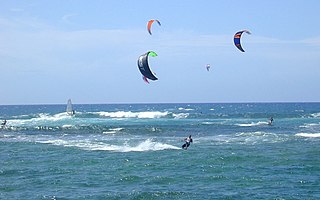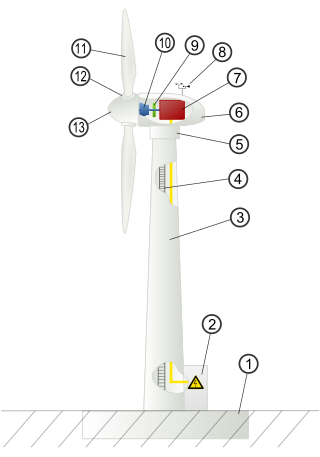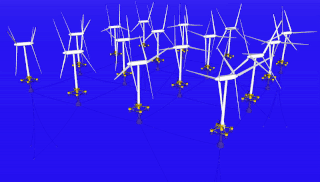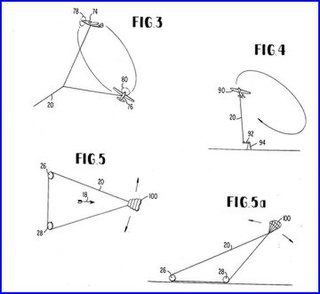
An aircraft is a vehicle that is able to fly by gaining support from the air. It counters the force of gravity by using either static lift or the dynamic lift of an airfoil, or, in a few cases, direct downward thrust from its engines. Common examples of aircraft include airplanes, helicopters, airships, gliders, paramotors, and hot air balloons.

A fixed-wing aircraft is a heavier-than-air flying machine, such as an airplane, which is capable of flight using wings that generate lift caused by the aircraft's forward airspeed and the shape of the wings. Fixed-wing aircraft are distinct from rotary-wing aircraft, and ornithopters. The wings of a fixed-wing aircraft are not necessarily rigid; kites, hang gliders, variable-sweep wing aircraft and airplanes that use wing morphing are all examples of fixed-wing aircraft.

Kiteboarding or kitesurfing is a sport that involves using wind power with a large power kite to pull a rider across a water, land, or snow surface. It combines the aspects of paragliding, surfing, windsurfing, skateboarding, snowboarding, and wakeboarding. Kiteboarding is among the less expensive and more convenient sailing sports.

A power kite or traction kite is a large kite designed to provide significant pull to the user.

The Darrieus wind turbine is a type of vertical axis wind turbine (VAWT) used to generate electricity from wind energy. The turbine consists of a number of curved aerofoil blades mounted on a rotating shaft or framework. The curvature of the blades allows the blade to be stressed only in tension at high rotating speeds. There are several closely related wind turbines that use straight blades. This design of the turbine was patented by Georges Jean Marie Darrieus, a French aeronautical engineer; filing for the patent was October 1, 1926. There are major difficulties in protecting the Darrieus turbine from extreme wind conditions and in making it self-starting.
For fixed-wing aircraft, autorotation is the tendency of an aircraft in or near a stall to roll spontaneously to the right or left, leading to a spin.
Kite types, kite mooring, and kite applications result in a variety of kite control systems. Contemporary manufacturers, kite athletes, kite pilots, scientists, and engineers are expanding the possibilities.

Wubbo Johannes Ockels was a Dutch physicist and astronaut with the European Space Agency who, in 1985, became the first Dutch citizen in space when he flew on STS-61-A as a payload specialist. He later became professor of aerospace engineering at Delft University of Technology.
A foilboard, also known as a hydrofoil board or foil surfboard, is a type of board used in water sports; it is distinct from surfboards in that it has a hydrofoil rather than fins mounted underneath. This hydrofoil design allows the surfboard and its rider to rise above the water’s surface, allowing for fast speeds and increased maneuverability in a wide range of surf conditions. Foilboards are becoming increasingly popular across many water sports, including surfing, kiteboarding, and wakeboarding. Foilboards have also been used in competitions, with riders reaching speeds of up to 30 km/h while performing acrobatic maneuvers such as flips, twists, and more.

An airborne wind turbine is a design concept for a wind turbine with a rotor supported in the air without a tower, thus benefiting from the higher velocity and persistence of wind at high altitudes, while avoiding the expense of tower construction, or the need for slip rings or yaw mechanism. An electrical generator may be on the ground or airborne. Challenges include safely suspending and maintaining turbines hundreds of meters off the ground in high winds and storms, transferring the harvested and/or generated power back to earth, and interference with aviation.
Airborne wind energy (AWE) is the direct use or generation of wind energy by the use of aerodynamic or aerostatic lift devices. AWE technology is able to harvest high altitude winds, in contrast to wind turbines, which use a rotor mounted on a tower.

Wind turbine design is the process of defining the form and configuration of a wind turbine to extract energy from the wind. An installation consists of the systems needed to capture the wind's energy, point the turbine into the wind, convert mechanical rotation into electrical power, and other systems to start, stop, and control the turbine.

Unconventional wind turbines are those that differ significantly from the most common types in use.
Different types of flying kites have niche applications. In nature, some animals, such as spiders, also make use of kiting.

Kites are tethered flying objects which fly by using aerodynamic lift, requiring wind for generation of airflow over the lifting surfaces.
KiteGen is a concept for a wind harnessing machine for high altitude winds, developed in Italy. The vertical axis rotation is intended to eliminate the static and dynamic problems that limit the size of conventional wind turbines. The prototype STEM yo-yo is under construction at Berzano di San Pietro in Italy.
Makani Technologies LLC was an Alameda, California-based company that developed airborne wind turbines. Founded in 2006, Makani was acquired by Google in May 2013. In February 2020, Makani was shut down by Alphabet, Google's parent company.

Crosswind kite power is power derived from airborne wind-energy conversion systems or crosswind kite power systems (CWKPS). The kite system is characterized by energy-harvesting parts flying transverse to the direction of the ambient wind, i.e., to crosswind mode; sometimes the entire wing set and tether set is flown in crosswind mode. From toy to power-grid-feeding sizes, these systems may be used as high-altitude wind power (HAWP) devices or low-altitude wind power (LAWP) devices without having to use towers. Flexible wings or rigid wings may be used in the kite system. A tethered wing, flying in crosswind at many times wind speed, harvests wind power from an area that exceeds the wing's total area by many times.
Kitepower is a registered trademark of the Dutch company Enevate B.V. developing mobile airborne wind power systems. Kitepower was founded in 2016 by Johannes Peschel and Roland Schmehl as a university spin-off from the Delft University of Technology’s airborne wind energy research group established by the former astronaut Wubbo Ockels. The company is located in Delft, Netherlands, and currently comprises 18 employees (2018).

A vertical-axis wind turbine (VAWT) is a type of wind turbine where the main rotor shaft is set transverse to the wind while the main components are located at the base of the turbine. This arrangement allows the generator and gearbox to be located close to the ground, facilitating service and repair. VAWTs do not need to be pointed into the wind, which removes the need for wind-sensing and orientation mechanisms. Major drawbacks for the early designs included the significant torque ripple during each revolution, and the large bending moments on the blades. Later designs addressed the torque ripple by sweeping the blades helically. Savonius vertical-axis wind turbines (VAWT) are not widespread, but their simplicity and better performance in disturbed flow-fields, compared to small horizontal-axis wind turbines (HAWT) make them a good alternative for distributed generation devices in an urban environment.











